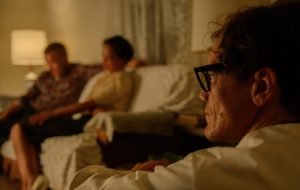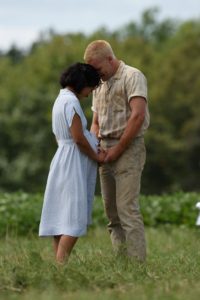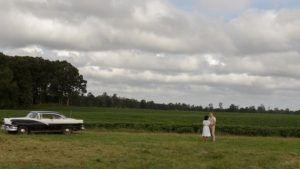 According to cinematographer Adam Stone, writer/director Jeff Nichols is very exacting with his words. Everything was spelled out in Loving, the story of Richard (Joel Edgerton) and Mildred Loving (Ruth Negga), an interracial couple, whose fight to have their marriage recognized in their home state of Virginia, went all the way to the US Supreme Court.
According to cinematographer Adam Stone, writer/director Jeff Nichols is very exacting with his words. Everything was spelled out in Loving, the story of Richard (Joel Edgerton) and Mildred Loving (Ruth Negga), an interracial couple, whose fight to have their marriage recognized in their home state of Virginia, went all the way to the US Supreme Court.
Because the film was a historical piece, Nichols and Stone began developing the vision for the film by viewing the HBO documentary by Nancy Buirski, 16 mm documentary footage on the Lovings – black and white from the fifties, and color footage from later years – as well as photo essays on the Lovings by LIFE photographer, Grey Villet.
“I’d seen some of Grey Villet’s stuff in sports. I didn’t really know him, but I knew a couple of his pictures,” commented Stone. “Then I saw the Loving stuff and I was blown away at how authentic and simple and caring, and to be honest, the love and time that he took for each photo. He had to just sit there, waiting for the Lovings to let their guard down and just be themselves.”
The film recreated some of those real moments, like Richard relaxing with his head on Mildred’s lap as they watched television, framing the scene as in the photographs. Villet, who never used lights or flashes in his photography, wanted his work to be very naturalistic. The photojournalist is quoted as saying “I want to get as real as real gets.” That comment resonated with Stone who adapted a naturalistic style for the film’s deep exploration of these people’s lives.
 “Especially on this movie, we wanted to be very real. From the production design, to the camerawork, to the lighting, simple and authentic is what we were striving for,” stated Stone. “We wanted to let the talent have an amazing space and location to work within, and really have the camera trained on them.”
“Especially on this movie, we wanted to be very real. From the production design, to the camerawork, to the lighting, simple and authentic is what we were striving for,” stated Stone. “We wanted to let the talent have an amazing space and location to work within, and really have the camera trained on them.”
The movie and the camera never strays away from the Lovings personally, that is why there are no long drawn out court scenes. What is there is very concise and deliberate. Stone’s camera perfectly captures Edgerton’s portrayal of Richard as a quiet, introspective person who tended to be still except for when he was working. The first time Stone shot Negga was during a camera test. He noticed how expressive her eyes were.
“Her eyes were phenomenal, kind of like Betty Davis. She doesn’t have to say anything during this movie. She says it all non-verbally,” shared Stone. “I was captivated.”
One of Stone’s favorite scenes – an interior night in the farmhouse with Villet first talking to Mildred – was inherently flawed because the film was not sitting correctly in the gate but it was both beautiful as well as flawed. It was simply lit using a baton strip of tungsten lights on the ceiling behind them and a muslin teaser to keep the shadows off the walls.
 Growing up watching “film films,” Stone has always shot on film with anamorphic lenses. Loving was shot using mainly 250D Vision 3 and 500T Vision 3 film stock. The use of film was also complimentary to the time period of the story.
Growing up watching “film films,” Stone has always shot on film with anamorphic lenses. Loving was shot using mainly 250D Vision 3 and 500T Vision 3 film stock. The use of film was also complimentary to the time period of the story.
Stone believes the look of anamorphic film is “the closest rendition of what we conceptualize as vision.” For him digital is a different beast. It’s hard to emulate the look of film, although the technology, including lenses, is getting closer and taking the edges off the harshness and hyper-reality of digital.
“Your eye picks up if something is digital, as opposed to film. Your brain knows that something shot on film with these lenses looks better, for whatever reason, than digital,” noted Stone. “As filmgoers we always like the combination of anamorphic lenses, specifically Panavision, with film. That’s our recipe.”





